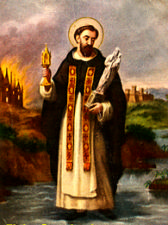Lives of the Saints
Our Models and Protectors
Spiritual Bouquet:
August 17

Saint Hyacinth
Missionary Preacher
and Thaumaturge
(† 1257)
Saint Hyacinth, named the glorious Apostle of the North, was born of noble parents in Poland, about the year 1185. In 1218, as a Canon of Cracow he accompanied the bishop of that region to Rome. There he met Saint Dominic and soon afterward was one of the first to receive the habit of the Friar Preachers, in a group clothed by the patriarch himself. He became a living copy of his dear master. The church was his only chamber, and the ground his only bed. So wonderful was his progress in virtue that within a year Dominic sent him with a small group to preach and plant the Order in Poland, where he founded two houses.
His apostolic journeys extended over numerous and vast regions. Austria, Bohemia, Livonia, the shores of the Black Sea, Tartary, Northern China in the east, Sweden, Norway and Denmark to the west, were evangelized by him, and he is said to have visited Scotland. Everywhere he traveled unarmed, without a horse, with no money, no interpreters, no furs in the severe winters, and often without a guide, abandoning to Divine Providence his mission in its entirety. Everywhere multitudes were converted, churches and convents were built; one hundred and twenty thousand pagans and infidels were baptized by his hands. He worked many miracles; at Cracow he raised a dead youth to life. He had inherited from Saint Dominic a perfect filial confidence in the Mother of God; to Her he ascribed his success, and to Her aid he looked for his own salvation. It was at the request of this indefatigable missionary that Saint Thomas Aquinas wrote his famous philosophical Summa contra Gentiles, proving the reasonableness of the Faith on behalf of those unfamiliar with doctrine.
While Saint Hyacinth was at Kiev the Tartars sacked the town, but it was only as he finished Mass that the Saint heard of the danger. Without waiting to unvest, he took the ciborium in his hands, and was leaving the church. Then occurred the most famous of his countless prodigies. As he passed by a statue of Mary a voice said: Hyacinth, My son, why do you leave Me behind? Take Me with you... The statue was of heavy alabaster, but when Hyacinth took it in his arms it was light as a reed. With the Blessed Sacrament and the statue he walked to the Dnieper river, and crossed dry-shod over the surface of the waters to the far bank.
On the eve of the Assumption, 1257, he was advised of his coming death. In spite of an unrelenting fever, he celebrated Mass on the feast day and communicated as a dying man. He was anointed at the foot of altar, and died on the great Feast of Our Lady.
Reflection: Saint Hyacinth teaches us to spare no effort in the service of God, but to rely for success not on our industry but on the assistance and prayer of His Immaculate Mother.
Little Pictorial Lives of the Saints, a compilation based on Butler's Lives of the Saints and other sources by John Gilmary Shea (Benziger Brothers: New York, 1894).